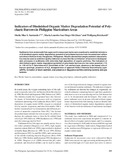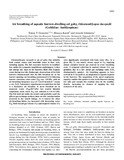Indicators of diminished organic matter degradation potential of polychaete burrows in Philippine mariculture areas
- Global styles
- MLA
- Vancouver
- Elsevier - Harvard
- APA
- Help
Share
นามธรรม
Sediments from underneath fish cages and in mesocosm tanks were examined to establish indicators of diminished organic matter degradation potential of polychaete burrows from increased mariculture activities in Bolinao-Anda, Pangasinan, Philippines. Results showed that simple sediment characteristics may be used as sediment quality indicators to describe the contribution of burrows to biodegradable processes in sediments with extremely high deposition of organic particles. The indicators of diminished organic matter degradation potential of polychaete burrows are low redox potential (-113 to -150 mV for F. Spionidae and F. Eunicidae) at the 1 cm surface layer, absence or decreased size of burrow openings, presence of H sub(2)S, disappearance of apparent Redox Potential Discontinuity Layer (aRPD), formation of black sediment, and presence of Beggiatoa (sulfide oxidizing bacteria) and gas bubbles.
การอ้างอิง
Santander, S. M. S., San Diego-McGlone, M. L., & Reichardt, W. (2008). Indicators of diminished organic matter degradation potential of polychaete burrows in Philippine mariculture areas. The Philippine Agricultural Scientist , 91(3), 295-300. http://hdl.handle.net/10862/2085
Type
ArticleISSN
0031-7454คอลเลกชัน
- Journal Articles [1258]
Related items
Showing items related by title, author, creator and subject.
-
Intertidal burrows of the air-breathing eel goby, Odontamblyopus lacepedii (Gobiidae: Amblyopinae)
Gonzales, Tomas T.; Masaya, Katoh; Ishimatsu, Atsushi (Ichthyological Society of Japan, 2008)Odontamblyopus lacepedii inhabits burrows in mudflats and breathes air at the surface opening. Investigations of the intertidal burrows using resin casting demonstrated a highly branched burrow system. The burrows are ... -
Gill structure, anatomy and habitat of Anodontia edentula: Evidence of endosymbiosis
Surveys and interviews were conducted to determine sources and habitat of Anodontia edentula. Results showed that they inhabit muddy substrate of mangrove areas or the adjacent mudflats, burying at 20-60 cm deep in the ... -
Air breathing of aquatic burrow-dwelling eel goby, Odontamblyopus lacepedii (Gobiidae: Amblyopinae)
Gonzales, Tomas T.; Katoh, Masaya; Ishimatsu, Atsushi (Company of Biologists, 2006)Odontamblyopus lacepedii is an eel goby that inhabits both coastal waters and intertidal zones in East Asia, including Japan. The fish excavates burrows in mudflats but, unlike the sympatric amphibious mudskippers, it does ...






